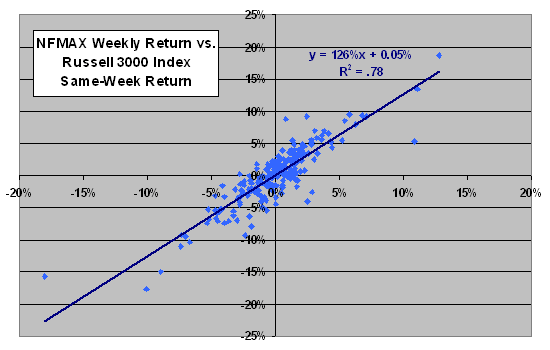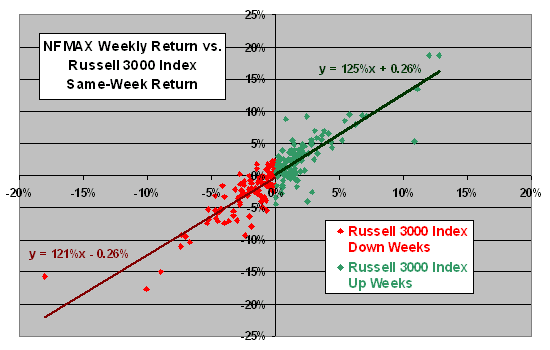Navellier & Associates, Inc. offers one Navellier-branded mutual fund, Navellier Fundamental A (NFMAX), “designed to achieve the highest possible returns while minimizing risk.” Selection criteria for fund holdings, re-measured quarterly, “include earnings growth, profit margins, reasonable price/earnings ratios based on expected future earnings, and various other fundamental criteria.” Using NFMAX weekly adjusted closing prices from inception in May 2005 through July 2009 and corresponding weekly levels of the Russell 3000 index as a self-selected benchmark, we find that:
The following scatter plot relates weekly NFMAX return to same-week Russell 3000 index return over the entire sample period. The the R-squared statistic of 0.78 indicates that variation in the Russell 3000 index explains about 78% of the variation of NFMAX. The slope of the best-fit line (beta) is 1.26, indicating that NFMAX is substantially more volatile than the index. The y-intercept (weekly alpha) is 0.05%, indicating that NFMAX has provided some outperformance due to stock picking. However, indicative of the small sample or the non-normality of return distributions, exclusion of as few as two weekly observations makes the positive alpha disappear.
Substituting the investable iShares Russell 3000 Index (IWV) exchange-traded fund for the underlying index results in an R-squared statistic of 0.70, a beta of 1.29 and an alpha of 0.02%. However, again indicative of the small sample or the non-normality of return distributions, exclusion of a single extreme weekly observation can switch the alpha from positive to negative.
During this relatively short test period, stock picking has contributed a small but not reliable positive net alpha.
Next we look at market timing performance.

The fund may invest in “cash, or cash equivalents, for temporary defensive purposes or depending on market conditions, if we believe it will help protect the Portfolio from potential losses…” Material shifts in fund holdings to cash at the right times for defensive purposes should substantially reduce portfolio beta when the market declines. The next scatter plot relates NFMAX and Russell 3000 Index weekly returns separately for Russell 3000 Index down weeks and up weeks.
Beta is slightly lower for index down weeks than index up weeks (1.21 versus 1.25), but the subsamples are probably too small to conclude that the difference is meaningful. (For example, exclusion of one extreme down-week observation increases the beta for down weeks to 1.45.)
Note (with caution due to the limited subsample sizes) that NFMAX weekly alpha is materially negative during index down weeks and materially positive during index up weeks. The fund therefore gets a double boost (alpha plus beta) during market up weeks and a double whammy during market down weeks.

In summary, performance of Navellier & Associates, Inc. name-brand mutual fund at the weekly level over the past four years does not provide compelling evidence of reliable net benchmark outperformance based on either stock picking or market timing.